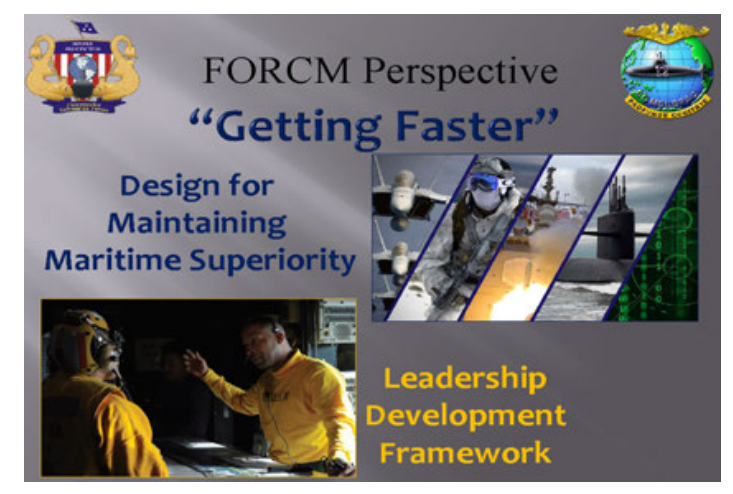
Good afternoon Admirals, Retired Admirals, Captains and retired Captains, I am Force Master Chief Paul Davenport. It is an honor to have the opportunity to share with you all some highlights from combined efforts of SUBLANT and SUBPAC to meet the expectations of our Navy’s Design for Maintaining Maritime Superiority and our Leadership Development Framework.
In keeping with this year’s theme, we are dedicated to Strengthening our Navy Team for the Future and enhancing our war-fighting and operational competence as well as developing Sailors with strong character and Getting Results Faster.
I’ll be providing an overview of improvements to our COB development process and the Hugh McCracken Award. Each of these efforts to positively affect policy will without a doubt strengthen our culture of critical self assessment and striving to become the best leaders we can be in order to precisely guide and develop our 21St Century Sailors. Additionally, I will be highlighting some of our submarines, ships and personnel that have been working their rear-ends off in defense of freedom and democracy across the globe.
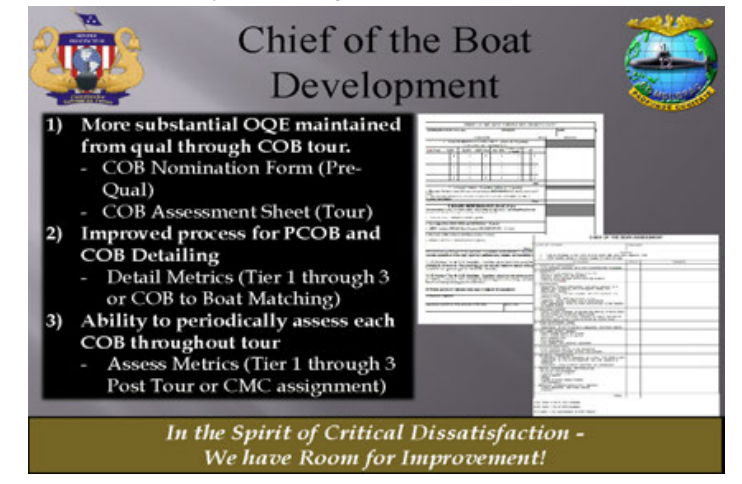
At the beginning of FY 17, we looked at COB qualifications through a microscope following a few detachments for cause and early reliefs of a few of our COBs. In the spirit of “Critical Dissatisfaction”, we identified that while the process was thorough, we still had room for improvement. In the past we did not have any measures in place to make a clear objective assessment of where to best place our prospective COBs.
In most cases we would qualify a Sailor, in some cases late, and just prior to their planned rotation date. Then we relied on a Squadron CMC to identify what boat they would be stationed on for their COB tour. This prevented us from aligning skill sets with boat performance and in some cases drove just in time detailing. Through our new process we have established objective quality evidence.
We now assign a Tier number (1 thru 3) to our prospective COBs. The score that they receive on the COB nomination grading sheet is 75 percent objective and 25 percent is subjective based on their performance in the COB board. We then take the Tier number and align them to a boat to achieve the best fit.
We maintain track of our boat and crew performance through Squadron assessments, external inspections (TRE/ORSE/SMI) and people centered-metrics. The Squadron CMCs and Force Master Chiefs evaluate the best placement for our prospective COBs by aligning the tier number of the Sailor to the boat. For instance, we will never place a tier 2 COB on a tier 3 boat, but we would most certainly take a Tier 1 candidate and place him or her on a Tier 3 boat (One that is struggling to deliver results).
Not only have our recent changes allowed us to set our boat crews and COBs up for success, it brings more visibility to our detailing process for Sailors seeking COB qualifications, and lastly allows us to get left of the problem. Another important factor is we force assignment more than 9 months out, no more just in time detailing.
What we have found is that due to all these efforts, more visibility and fairness, we are able to build a deeper bench of prospective COBs and to date we have not had to assign any Tier 3 COBs to any boat. In fact, we can send our Tier 3 COBs back to sea to gain more experience. When a Sailor completes this new qualification standard they clearly understand where they stack up in comparison to their peers and it clearly identifies their strengths and weaknesses.
Once we had a solid process in place for COB detailing, we then expanded our ability to critically assess serving COBs with the same approach to establishing objective quality evidence. We had identified instances where COBs had hit the ground running and kept crews and boats at a high standard of performance, but in their final year they some times would become too comfortable and performance and productivity would decline. We also identified that we weren’t able to provide clear assessment factors for future assignment as a CMC.
Now, 18 to 24 months into their COB tour, we assess them in 10 critical areas of performance. This assessment tool is provided to their Commanding Officers and Commodores, then the CMC routes the assessment to the Force Master Chiefs. This assessment is used to stack and rack our serving COBs. Tier 1 and 2 COBs are identified for future assignment as Command Master Chiefs and Tier 3 COBs are provided a post tour COB assignment or they may be returned to their source rate detailer. A great by-product of this assessment and detailing process has given the submarine force Sailors a clear understanding of the Senior Enlisted Career path.
Force Perryman and I have set our sights on developing our COBs to not only feed the submarine CMC assignments, but to also support the high demand of the Surface and Air communities. The submarine force has 101 COB billets. On average we rotate 30 COBs a year and between our 44 9580 (CMC) billets and 27 9579 (post tour COB) billets we only require 16 to 20 of these post tour COBs in submarine force billets. This permits us the ability to release numerous COBs to fill demanding a critical CMC billets in the surface and air communities.
We are working diligently with our great, well trained Senior Enlisted Submariners to bring much needed attention to all the awesome opportunities in our Navy to serve in great commands outside the Sub- marine Force. We’ve crunched the numbers and on average our COBs report to their COB tour around their 19th year of service, which supports them serving as a CMC for 8 years or more. Our overall message
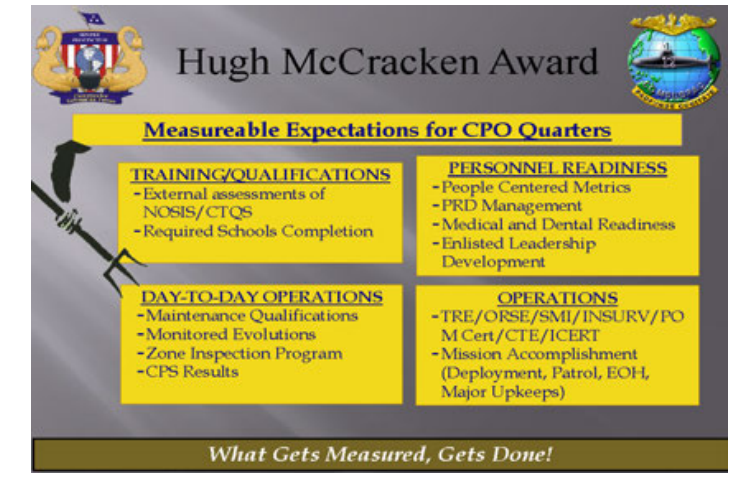
to our Senior Enlisted is your Chief of the Boat tour is a milestone that all great leaders should strive to achieve. We have and will continue to produce top leaders in our Navy and we are pushing harder than ever to spread this wealth of knowledge and experience throughout our Navy and joint forces assignments.
Now we transition from developing a stronger Leader that leads the Chiefs Quarters to developing a set of standards that challenges our Chief Petty Officers to become the best at producing the best Sailors. Separate from our Guiding Principles, we have never had a published set of metrics to measure what it takes to become a high functioning Chiefs Mess.
We identified key areas that we demand our Chiefs to focus on as they develop their Sailors and lead their divisions. The first and most essential area is Training/Qualifications. This includes reviewing qualification and proficiency of watch stations, training exams and oral interviews throughout the year, percentages for completion of required schools, both shipboard requirements and NEC specific schools.
The second is Day to Day Operations. This is where we evaluate the overall effectiveness in maintaining maintenance qualifications (craftsmen, QA workers, QAIs and QASs), monitored Evolutions conducted by external organizations, and finally something that is near and dear to a Chief of the Boat’s heart, the execution and effectiveness of the Zone Inspection Program, cleanliness, preservation and stowage results.
The third category we evaluate is Personnel Readiness. We are able to evaluate this on a monthly basis through people centered metrics, which clearly tell us what the Sailors are doing and how the Chiefs are delivering with respect to unplanned losses, qualifications, reenlistment rates and advancement percentages.
We also review PRD Management, Medical and Dental Readiness, Enlisted Leadership Development (Percentage of First Class Petty Officers and Chiefs qualified DOOW, ANAV, and percentage of Chiefs/Senior Chiefs qualified EDMC and COB).
The last attribute that we evaluate for determining which command is the best of the mess is, Operational Success, such as TRE/ORSE/SMI/INSURV/POM Eval/ CTE/ICERT, Mission Accomplishment (Deployment, Patrols, Shipyard Availabilities and Major Upkeep Periods).
After our Submarine Squadrons stacked and racked their individual units, FORCM Perryman and I chaired a selection board and on behalf of Vice Admiral Tofalo and Rear Admiral Caudle, we are proud to announce our inaugural year’s winners.
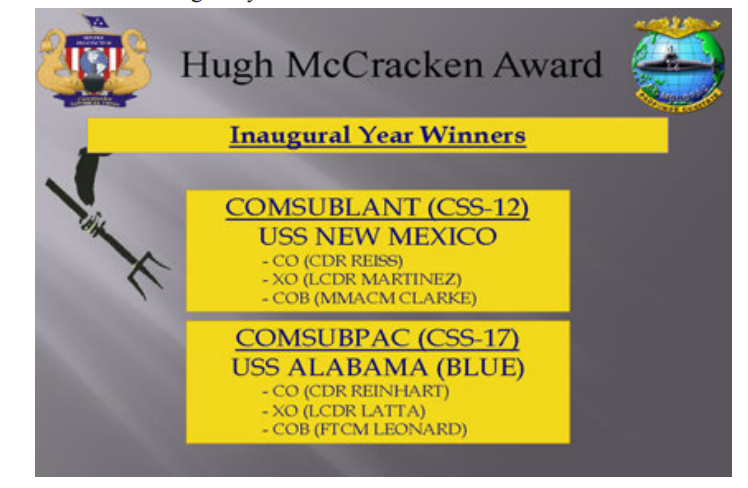
Representing COMSUBLANT, and Squadron Twelve, USS New Mexico. Commanded by Commander REISS with Lieutenant Commanders GARNER and MARTINEZ as Executive Officers and Chief of the boat, Master Chief CLARKE.
Representing COMSUBPAC, and Squadron Seventeen, USS Alabama (BLUE). Commanded by Commander REINHART, and Lieu- tenant Commander Low and Latta as Executive Officers and Chief of the Boat Master Chief LEONARD.
THE FOLLOWING COMMANDS WERE RECOGNIZED AS THE BEST OF THE BEST IN THEIR RESPECTIVE SUBMARINE SQUADRONS:
Squadron Four: USS Minnesota, Squadron Six USS Helena, Squad ron Sixteen USS Georgia (GOLD), Squadron Twenty USS West Virginia (BLUE), Squadron One USS Mississippi, Devron Five USS Jimmy Car- ter, Squadron Seven USS Louisville, Squadron Eleven USS Pasadena, Squadron Fifteen USS Key West, and Squadron Nineteen USS Michigan (BLUE).
We are confident that the recognition will spawn a culture that brings continued SUCCESS, DRIVES MISSION READINESS, AND ENABLES crews to become stronger. After this year’s results, we are also reassured that our force is aligned and pushing to excel in all areas critical to war fighting and operational competence and building stronger character in our Sailors.
Now I would like to take you on a quick tour around the Pacific Fleet.
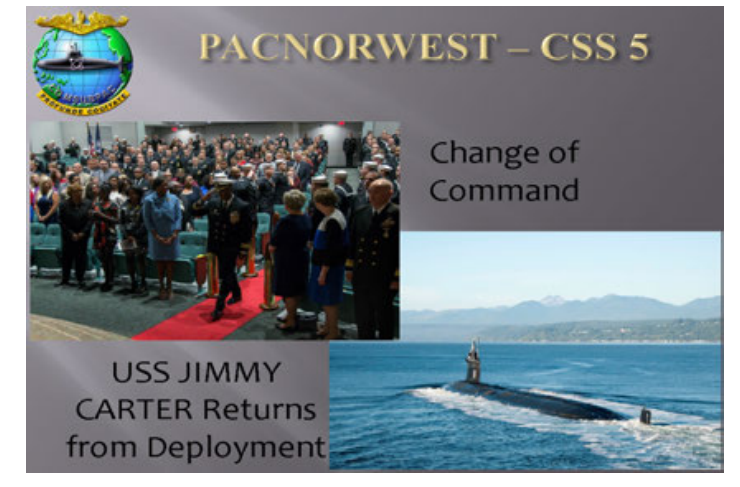
Our first stop is PACNORWEST, where we find an armada of lethal submarines. Nowhere else in our Navy will you ever find more fire power in one homeport. Not only do we have 16 crews operating the world’s deterrent to nuclear conflict in our eight SSBNs, you will also find our two great ships that bring a much needed presence in the SEVENTHFLT AOR, our Forward Deployed SSGNs, and then lastly we have three rare submarines built to win the Cold War in our Seawolf Class.
In October Commander Melvin Smith turned over the reins of the Seawolf-class fast attack submarine USS Jimmy Carter (SSN 23) to Commander Keith Floyd just 3 weeks after returning from their recent deployment.
As our Submarine Force Commanders have previously stated, Development Squadron Five has done a superb job keeping Jimmy Carter, Connecticut and Seawolf at a high state of readiness. Soon we will have all three of these boats operational as Connecticut is marching along in our Fleet Readiness Training Period and then at the first of the year, in January, we will get Seawolf out on sea trials.
This past year, the Ohio-class ballistic-missile submarine USS Ne-braska completed sea trials and returned to service due to the great
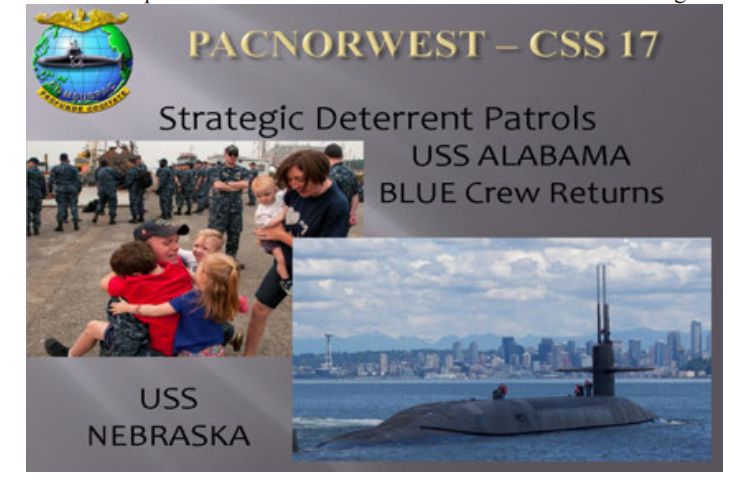
work that our shipyards continue to provide. The crew was excited to get this great ship back in service following an extended engineering refueling overhaul.
Another one of our eight ballistic missile submarines in the Pacific Northwest that provides us our most survivable leg of the strategic triad, USS Alabama crews completed multiple strategic deterrent patrols. Chief Electronics Technician Goodwin, assigned to the Blue crew was welcomed home by his family following one of those strategic deterrent patrols. And as you recall in my earlier slides this ship reached and maintained high standards obtaining the title of the best Chiefs’ Quarters in the Pacific.
In January 2017 Michigan deployed for the Western Pacific and re- mains a ready forward deployed asset. I had the pleasure of riding the
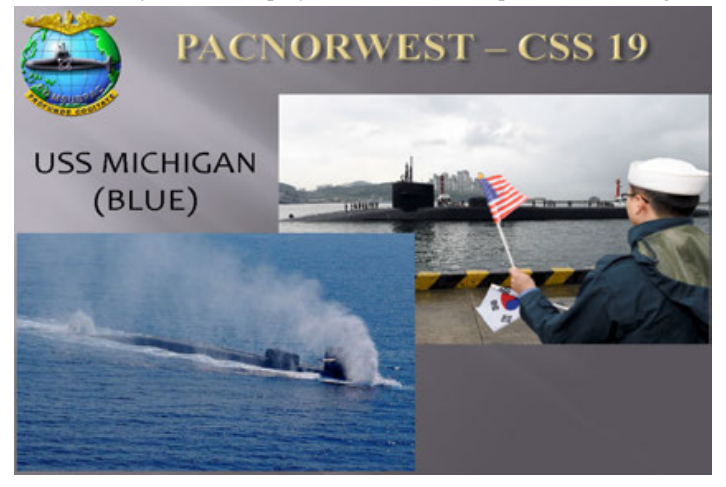
boat when CAPT Turk’s BLUE crew took the boat for the first time in theatre following extensive repairs in the shipyard. In March I watched a very talented crew, highly motivated with a strong sense of pride and positive culture throughout. The deployment in the spring was historical, in that we had come full circle with our integration of females in submarines.
I was simply amazed as I witnessed young first term female submariners lock step with the men. Between the Michigan Blue and Gold crew, we had 54 junior enlisted and six senior enlisted women into the force. The strong leadership onboard Michigan ensured the smooth transition of each Sailor into a professional environment. Michigan’s enlisted women earned 24 sets of silver dolphins and qualified over 100 at sea and in-port watches.
During a period of escalating world tensions, Michigan was called upon to participate in Theater Security to improve regional stability and build upon our strong partnership with South Korea and the Republic of Korea Navy.
Now we transition from the Great PACNORWEST to this century’s Submarine Capitol of the World, Pearl Harbor. On the 10th of Aug, family and friends would welcome home their

Sailors assigned to Los Angeles-class attack submarine USS Jackson ville (SSN 699) during its homecoming arrival at Joint Base Pearl Harbor Hickam, after completing its final deployment of EIGHT MONTHS. Not bad for a submarine commissioned on May 16, 1981. The boat pro- vided superior Theatre presence in the 5th Fleet area of operations and Indian Ocean. One of the joys of this job, is being able to welcome our boats back from deployment and I’ll never forget standing there with the families as Jacksonville pulled in. The sights, sounds and emotions that flow through the submariner soul during these reunions is truly inspiring.
Another great old classic, boat USS Bremerton SSN-698 (BAD FISH) just departed for the ships final Deployment/WESTPAC. Bremer- ton was launched July 1978 and commissioned March 1981. It is unbelievable what we can accomplish with these great submarines. And going back to what Force Perryman stated, it’s all due to this awesome generation that is joining our Navy and volunteering for our service. Without these Sailors, our Navy’s Submarines, Ships and Aircraft life’s blood are nothing but hard cold steel. Our Sailors are truly our Secret Sauce.
Another Squadron One boat would bring the ARLEIGH BURKE FLEET TROPHY back to their squadron for the second year in a row. That’s right 688 fans, which I can confidently say I am after serving on 5 of them, back to back years where a Virginia Class submarine has won this prestigious award. USS Mississippi recently was presented their trophy by Admiral Swift just prior to departing for the ships second deployment. Oh, another interesting fact about Mississippi, a certain Force Master Chief has a son reporting aboard in a week as a Communications Electronics Technician. Clearly, he received an extra dose of intelligence from his mother because he didn’t grow up to be a Torpedoman like his dad.
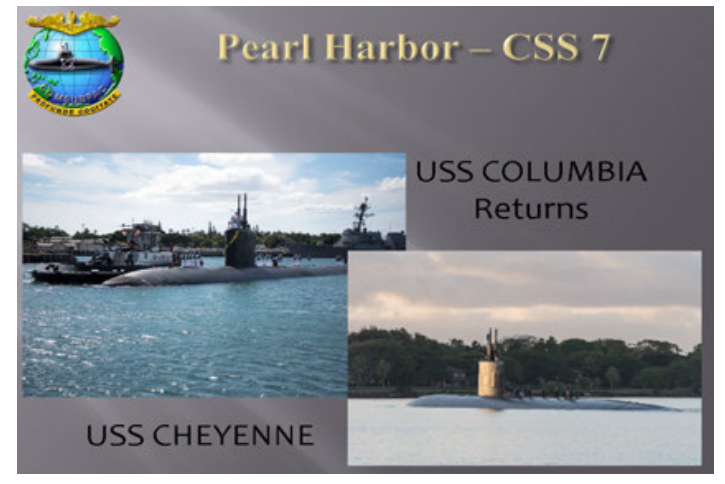
Squadron Seven relieved Squadron One this past year deploying the most submarines of any Squadron, in fact they had five boats in theatre at one time. USS Cheyenne and USS Columbia were two boats that re- turned last fall from highly successful deployments. Speaking of Columbia, they’re certainly well represented by our Frank A. Lister Award winner, Master Chief Torres.
Guam continues to be a top priority for Admiral Caudle and me as we look at expanding our footprint to five SSNs. Our strongest assets that will clearly allow for this build-up in Guam are our Submarine Tenders and the Sailors and MSC personnel that make up these great ships.
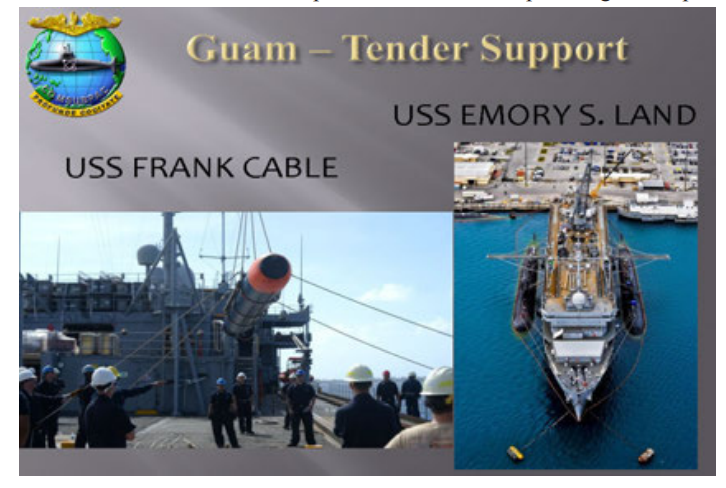
One of those Tenders that have been the work horse this year keeping the homeported submarines, Michigan and all our SEVETHFLT deployers from Pearl and San Diego operationally ready, USS Emory S. Land has answered the call time and time again. The last four upkeep periods have been completed on time improving upon our readiness of our Forward Deployed Naval Forces.
Another priority for us is to utilize our Tenders as an expeditionary logistics force and in March prior to Frank Cable going into a civilian shipyard in Oregon, we tested this mission in MAJURO, Republic of the Marshall Islands. Frank Cable’s Weapons Department, Navy Cargo Handling Battalion 1, Commander, Task Force 75 and USS Pasadena completed a demonstration exercise of submarine expeditionary logistics by shipping a training shape on and off the submarine.
In May of this year, USS Key West, the Arleigh Burke class guided missile destroyer USS Sterett, and the Royal Thai Navy frigate HTMS Naresuan and the corvette HTMS Long Lom conducted a transit exercise as part of Exercise Guardian Sea 2017. Sterett is part of the Sterett
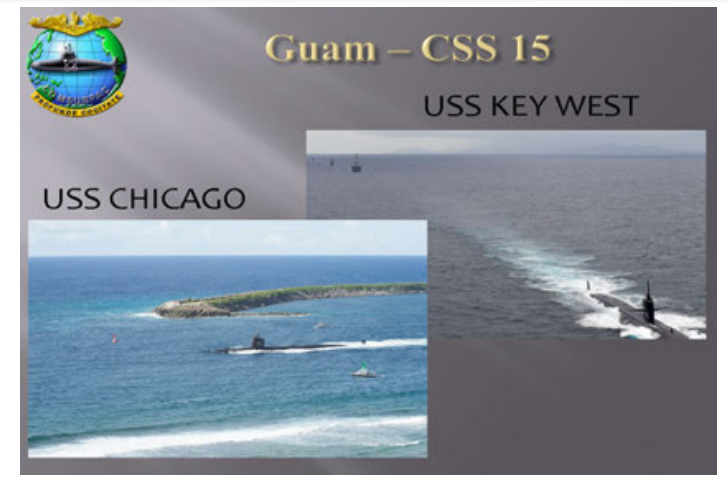
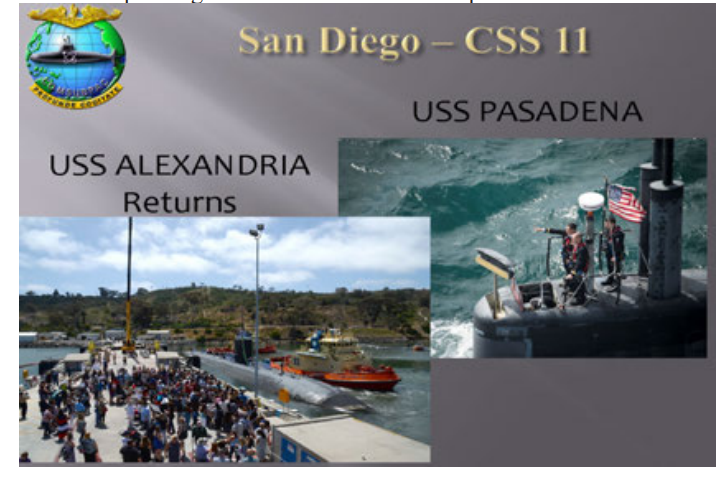
to the Pacific Fleet commander by leveraging the capabilities of 3rd and 7th Fleets.
About 2 months ago USS Chicago departed Apra Harbor for the last time as a homeported Guam unit. Chicago successfully completed an Operational Reactor Safeguards Examination during the ship’s transit from Guam to Pearl to fully recertify the crew and the ship. She will undergo a shipyard availability and we expect this ship back in theatre on deployment in 18 months.
In May, USS Alexandria returned to Naval Base Point Loma following a 6+ month extended deployment to SEVENTHFLT Theatre. This was the ship’s first deployment following her engineering refueling and overhaul in Portsmouth, New Hampshire. And I would be remiss if I did not compliment the great work that this shipyard completes.
While I was the Command Master Chief at Squadron Eleven, I was always impressed by the detail and quality of work, but never had I seen more pristine boats in my career. Now I’ve been onboard Alexandria, Scranton and Annapolis and they are all in top material condition.
In September USS Pasadena also completed a 6+ month extended deployment. Lt Martinez and LT James drive the boat on the surface inbound to Naval Base Point Loma returning from deployment. USS Pasadena also participated in the second annual Los Angeles Fleet Week this past September.
That concludes my brief. Thank you again for inviting me to this wonderful event. God Bless the United States of America and our great Submarine Force.

